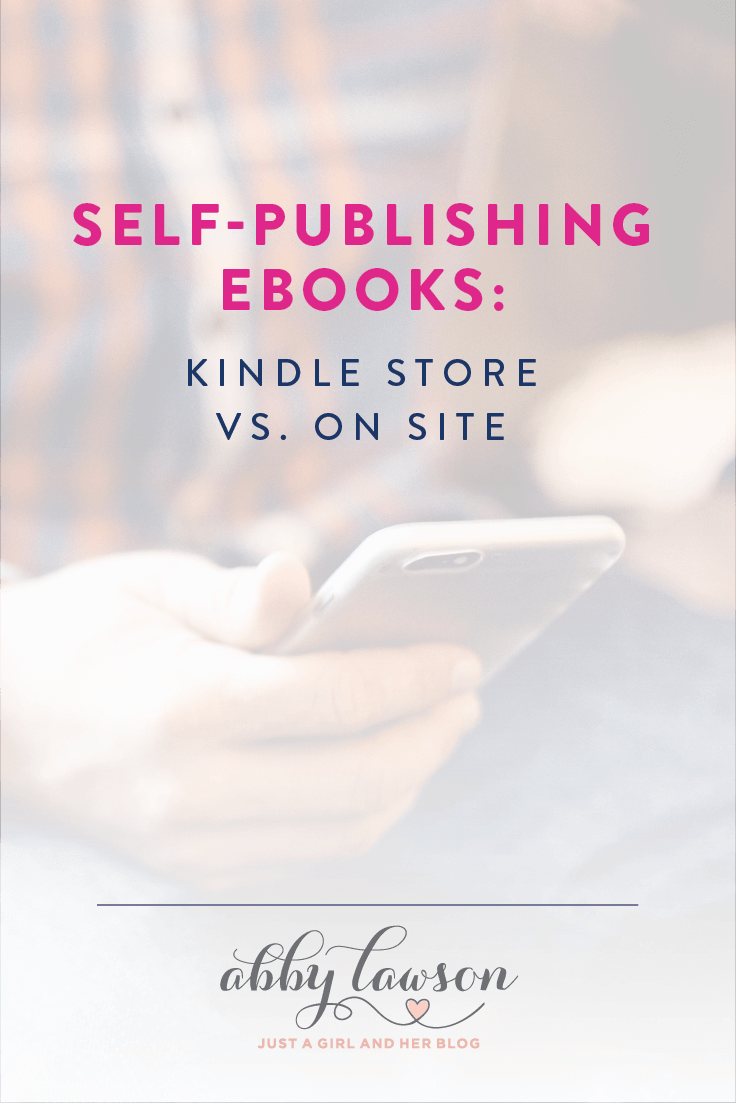Self Publishing eBooks: Kindle Store vs. On Site
There’s no doubt that over the past few years electronic books (eBooks) have taken off. It’s hard to argue with the convenience of having all of your books on all of your devices at all times.

From the author’s perspective, eBooks have erased many of the barriers of entry found in traditional publishing. Now, anyone can write a book and put it up for sale. Literary agents and publishing houses are becoming increasingly less important, even for well-known authors.
This is all great news for bloggers and online business owners as self-publishing eBooks is now an extremely viable income stream option. In fact, writing and publishing eBooks has taken Abby’s blog and turned it into a full time business for our family.
This is all very exciting, but the question we hear often from bloggers is whether they should sell their eBook in the Amazon Kindle Store or sell their eBook directly to customers on their blog or website.

Learn how to start a blog!
Get your new blog set up in a few short minutes with our easy-to-follow guide, and start growing your site today!
Should I sell my eBook in the Amazon Kindle Store or directly on my blog?
Abby and I are biased. We made the decision years ago to sell directly and forego the Kindle Store. That’s not to say that we won’t explore that marketing channel in the future, but for our business, selling directly has been a good decision. As I talk a little about how we came that conclusion, maybe these points will help inform your own decision.
Note: These conclusions assume you are writing and selling non-fiction books. Novels or works of fiction would require an entirely different set of considerations.
Why We Sell eBooks On Site Directly to Our Customers
Higher Prices
In general, you can charge more for an eBook sold directly on your site to your own audience. On Amazon, you’ll be selling largely to strangers who are considering your book along with dozens of other recommend titles. This tends to drive price down. Amazon has commoditized pricing whereas selling an eBook directly to your own audience you can use value-based pricing.
Control of Launch Process
Abby and I learned early on that a well-executed launch plan has a dramatic impact on the profitability of an eBook. When selling directly to customers on our site, we have more control over the pre-launch phase, launch phase, as well as new customer on-boarding process. You lose some of that control when selling eBooks in the Kindle Store.
Ongoing Relationship With Customers
Many Kindle book sales are one-off transactions. Because selling directly gives you access to your customers’ email addresses, you have more opportunities for follow-up email sequences and relationship fostering. Many of our customers continue to buy every eBook we release. Why? We’ve built a relationship with them. With Amazon, you don’t have access to your customers’ information. They are Amazon’s customers, not yours.
Formatting Options
If your eBook is image-heavy with charts, graphs, illustrations, or pictures, you have more options when creating a PDF file and selling it directly, as opposed to the formatting limitations of Kindle Store books.
Easy to Get Feedback
Abby and I have launched and then later re-launched the same eBook. We use surveys and customer feedback to improve our products to better help our customers. This has made a dramatic difference in our sales. With Amazon, the only feedback you receive are public reviews without a lot of detail.
Keep More of Your Profits
In addition to lower overall prices, Amazon generally pays authors 70% of revenue. If you sell your book for what Amazon considers too low or too high of a price, your profit changes to 35%. When selling an eBook directly on your site, you pay your credit card processor or PayPal a small transaction fee of a few percent. You keep the vast majority of the income from your sales.
Offer Multiple Packages With Pricing Tiers
After Abby and launched our first eBook, we listened to customer feedback and made improvements. When we re-launched, we used multiple pricing tiers and offered some video tutorials along with the eBook. These multiple tiers made a huge impact on our income. With Amazon, you can’t sell your eBook in multiple pricing tiers packaged with other files besides your eBook.
No External Link Restrictions
If you look at our income reports, you’ll notice that we make a substantial portion of our income from our affiliate partners. Many of these links are inside of our eBooks. If selling an eBook in the Kindle Store, you have to play by their rules and typically internal affiliate links are not allowed. You have to give up a nice potential revenue stream.
Affiliate Marketing Options
By selling directly, you have the opportunity of creating your own affiliate program and leveraging the audiences of other bloggers in your niche to sell your eBook. Using affiliates to sell your eBook in the Kindle Store is technically possible, but practically it’s not very viable. Abby and I typically pay our affiliates around 40%. This is much more appealing to potential affiliates than the few percent they receive from referring their audience to a book in the Kindle Store.
Play By Your Own Rules, Not Amazon’s Rules
When selling an eBook directly on your own site, you make the rules. You are in control. There’s tremendous power and freedom in that. When selling in the Kindle Store, you must understand and abide by Amazon’s rules which could change at any time. They are in control. They are Amazon’s customers and not yours. There’s more risk in building a business on someone else’s platform.
Build a Business Asset
A direct channel to your customers is a business asset that can grow over time. It’s a lot of work, but a list of customers who have purchased something from you is extremely valuable. With Amazon, you may earn some income, but you’re not building a long-term business asset that will keep giving back to you. Again, they are Amazon’s customers, not yours.
Common Objections to Selling eBooks Directly On Your Site
Even with the reasons listed above, there are still many who object to the idea of selling directly instead of in the Amazon Kindle Store. Here are the objections we hear most often…
I don’t have a big enough audience to sell directly on my site.
Many people are enamored with the massive potential market for their book in the Kindle Store. On some levels this makes sense, but at the same time you are competing with thousands of other books. Oftentimes this means competing on price, which drives prices down.
Sure, the potential audience is smaller selling on your own site, but that’s ok! We’ve seen over and over how bloggers can make thousands during an eBook launch selling only to an engaged email list of a few hundred. Anyone can build a targeted list of a few hundred people.
You really don’t need as big of an audience as you think. Plus, going through the launch process with a pre-launch lead magnet will help you to grow your list. Pre-launch and launch are usually times of tremendous list growth.
It’s hard to sell directly on my site because of all the technical requirements behind accepting payments and delivering the digital file.
It’s honestly very easy. On-site shopping cart options like Gumroad and SendOwl make it easy to collect payment and automatically deliver your eBook to customers.
Related: Essential Tools for Writing and Launching an eBook
Conclusion
Are we biased? Yes. But that’s only because writing and selling eBooks has had a profound impact on our lives and business. I’m confident that if we made the decision years ago to forego direct, on-site sales and only offer our books in the Kindle Store, we wouldn’t have had the same success.
Selling direct was a good decision for us (and many others!) but you need to make your own decision.

We’re sharing ALL of the tools we’ve used to grow our blog!
Stop the guessing game! Get our list of 100+ proven tips, tools, and resources that can take your blog/online business to the next level!

